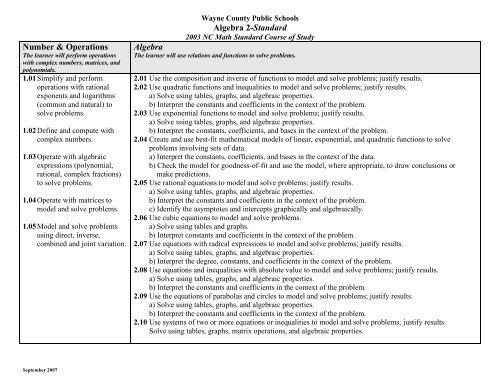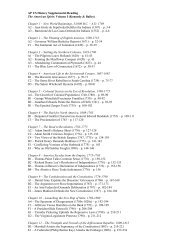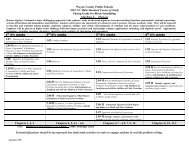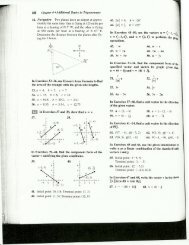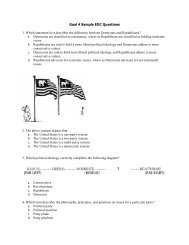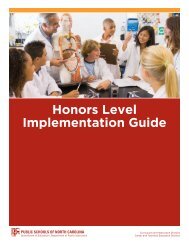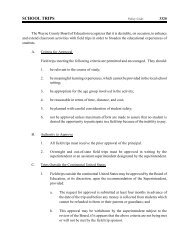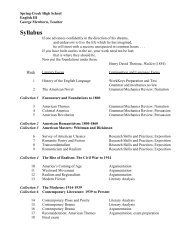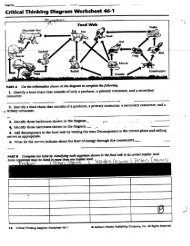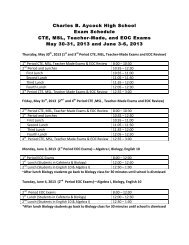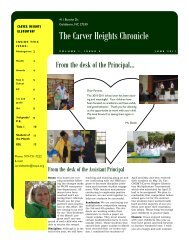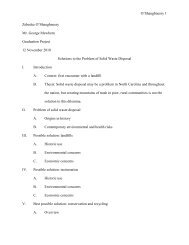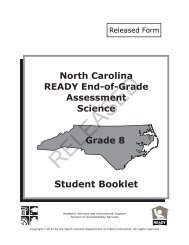Algebra 2 Standard Pacing Guide - Wayne County Public Schools
Algebra 2 Standard Pacing Guide - Wayne County Public Schools
Algebra 2 Standard Pacing Guide - Wayne County Public Schools
Create successful ePaper yourself
Turn your PDF publications into a flip-book with our unique Google optimized e-Paper software.
Number & Operations<br />
The learner will perform operations<br />
with complex numbers, matrices, and<br />
polynomials.<br />
1.01 Simplify and perform<br />
operations with rational<br />
exponents and logarithms<br />
(common and natural) to<br />
solve problems.<br />
1.02 Define and compute with<br />
complex numbers.<br />
1.03 Operate with algebraic<br />
expressions (polynomial,<br />
rational, complex fractions)<br />
to solve problems.<br />
1.04 Operate with matrices to<br />
model and solve problems.<br />
1.05 Model and solve problems<br />
using direct, inverse,<br />
combined and joint variation.<br />
<strong>Wayne</strong> <strong>County</strong> <strong>Public</strong> <strong>Schools</strong><br />
<strong>Algebra</strong> 2-<strong>Standard</strong><br />
2003 NC Math <strong>Standard</strong> Course of Study<br />
<strong>Algebra</strong><br />
The learner will use relations and functions to solve problems.<br />
2.01 Use the composition and inverse of functions to model and solve problems; justify results.<br />
2.02 Use quadratic functions and inequalities to model and solve problems; justify results.<br />
a) Solve using tables, graphs, and algebraic properties.<br />
b) Interpret the constants and coefficients in the context of the problem.<br />
2.03 Use exponential functions to model and solve problems; justify results.<br />
a) Solve using tables, graphs, and algebraic properties.<br />
b) Interpret the constants, coefficients, and bases in the context of the problem.<br />
2.04 Create and use best-fit mathematical models of linear, exponential, and quadratic functions to solve<br />
problems involving sets of data.<br />
a) Interpret the constants, coefficients, and bases in the context of the data.<br />
b) Check the model for goodness-of-fit and use the model, where appropriate, to draw conclusions or<br />
make predictions.<br />
2.05 Use rational equations to model and solve problems; justify results.<br />
a) Solve using tables, graphs, and algebraic properties.<br />
b) Interpret the constants and coefficients in the context of the problem.<br />
c) Identify the asymptotes and intercepts graphically and algebraically.<br />
2.06 Use cubic equations to model and solve problems.<br />
a) Solve using tables and graphs.<br />
b) Interpret constants and coefficients in the context of the problem.<br />
2.07 Use equations with radical expressions to model and solve problems; justify results.<br />
a) Solve using tables, graphs, and algebraic properties.<br />
b) Interpret the degree, constants, and coefficients in the context of the problem.<br />
2.08 Use equations and inequalities with absolute value to model and solve problems; justify results.<br />
a) Solve using tables, graphs, and algebraic properties.<br />
b) Interpret the constants and coefficients in the context of the problem.<br />
2.09 Use the equations of parabolas and circles to model and solve problems; justify results.<br />
a) Solve using tables, graphs, and algebraic properties.<br />
b) Interpret the constants and coefficients in the context of the problem.<br />
2.10 Use systems of two or more equations or inequalities to model and solve problems; justify results.<br />
Solve using tables, graphs, matrix operations, and algebraic properties.<br />
September 2007


